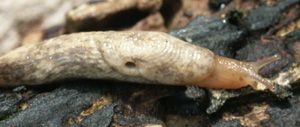Family:Limacidae
These slugs have the pneumostome (respiratory pore) situated on the right side of the body, behind the mid-line of the mantle; have a small internal asymmetrical shell plate; and the keel does not extend as far as the mantle, but slopes down towards the tail. The mantle bears a pattern of concentric rings, rather like a finger print. These slugs cannot contract into a hemispherical shape in the way Arionid slugs can.
There are five genera of Limacidae in Britain:
Limax and Limacus species are more than 5 cm. extended length when adult, and the keel slopes gently down to the tail. The pattern of concentric rings on the mantle is centred on the mid-line.
Lehmannia species are similar externally to Limax species, with the keel sloping gently down to the tail.
Malacolimax tenellus is the only representative of its genus in Britain. (See the Society Project involving this species.)
Deroceras species (now considered in the family Agriolimacidae) are smaller (usually less than 5 cm.) and the keel is truncated, turning down sharply to the tail. The pattern of concentric rings is centred to the right of the mid-line of the mantle just above the respiratory pore.
Click on the relevant image to continue.


